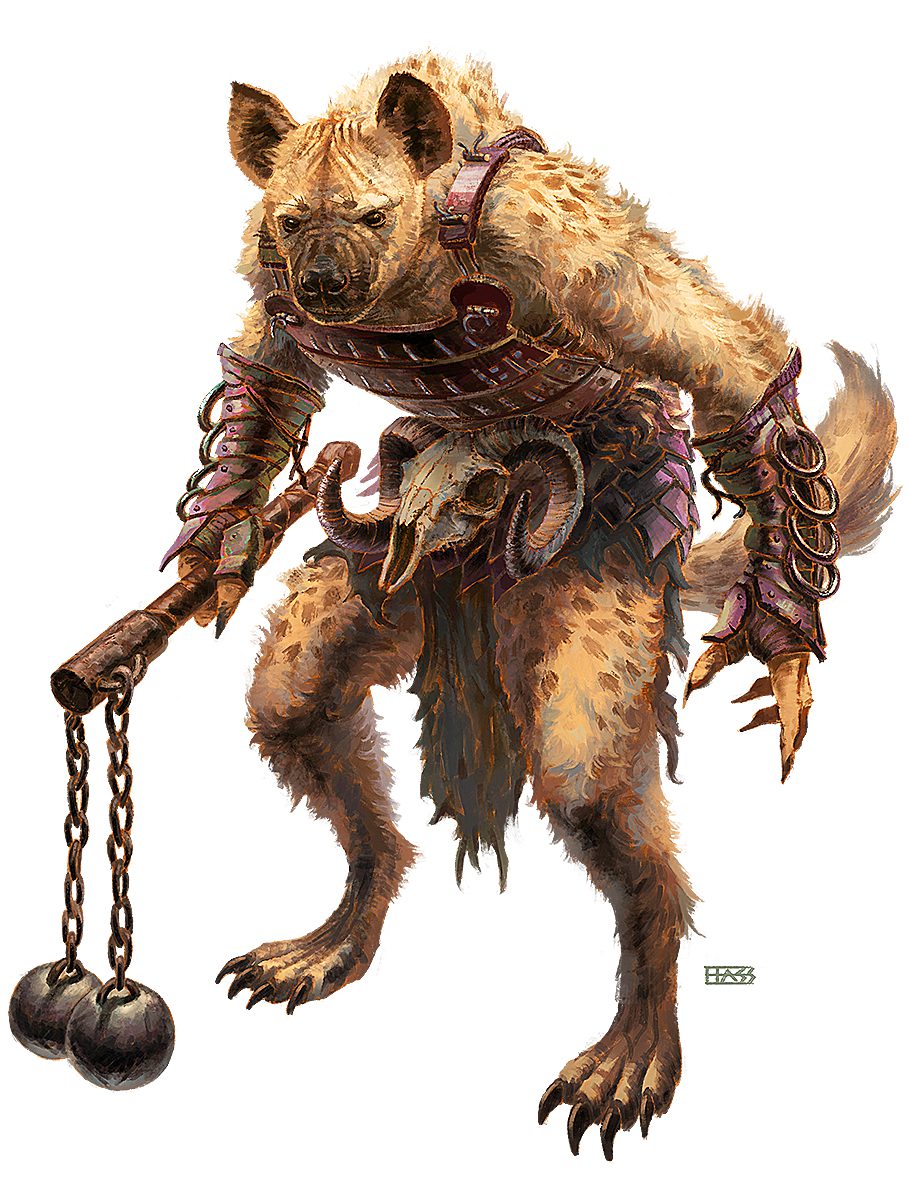
“Alright boss,” said Salma, “what’s the plan?”
“Should just be some gnoll outriders up there,” said Nur. “We shoot through them and then hail the ship. We’re cutting it close, but we should have at least a minute before they bail.
“What if, in theory, that have a giant hyena?” replied Salma.
“Why would they—” Nur stopped themself and looked over the rock they had hidden behind. “Ah,” they said, watching the horse-sized predator pace along the cliff-side. “New plan. Run for the beach as fast as you can and try not to be lunch.”
Now that we have our system for creating skirmishes, let’s put it into action. Our hypothetical party is a four-character group at 3rd level, consisting of an elven ranger, a dwarf warlock, a hobgoblin rogue, and a human bard. We know that while they put out a lot of damage and are very mobile, they’re fragile and don’t have anyone comfortable in melee. We also know that the entire party likes making dramatic leaps off of tall objects, which has gotten them into trouble with falling damage before, that dwarves only have a movement speed of 25 feet, and that no one has misty step.
This gives us an encounter budget ranging from 300 XP to 1,600 XP, depending on how difficult we want the fight to be.
With this in mind, let’s set up stakes and objectives. Our party has recently stolen vital information they need to get back to a friendly city. They’ve arranged for transport via a discrete boat, but they have a narrow window for extraction: if they take too long, the boat could leave without them, or it could be found and destroyed by their enemies, meaning that they’ll have to take the long way home and potentially risk the information getting home too late to be of use. This gives us stakes (a long trip home versus a safe and timely arrival) as well as a clear objective for the encounter (get to the beach before your ship leaves or is found—5-round time limit). If they fail, we’ll need a terminus, but we don’t need it to be particularly difficult, so we’ll just have it be to escape the fight (reach the other end of the map). This is a pretty simple objective with a generous time limit that plays to the group’s strengths as a troupe of mobile strikers, so we’re going to adjust the encounter difficulty down once we’ve finished the design.
As this skirmish is about reaching locations (the beach, or the other end of the map), terrain is going to be prominent, and we want it to play a big role in the encounter and determine how long it will take the party to complete their objectives. As such, the quickest route to the beach is 70 feet away and crosses 10 feet of difficult terrain as the path descends a cliff side. Additionally, we want to reward the party’s tendency to jump off of high places, so the option to jump off a cliff and reduce the trip by 30 feet of movement exists but also features up to 30 feet worth of falling damage. All characters can in theory complete the objective in 2 rounds of movement by dashing, though our Dwarf will need to dash both times. If they fail, the map edge is a mere 10–15 feet away.
To ramp up the challenge, we’re also adding some movement and line-of-sight blockers, forcing characters to risk melee if they want to take the most efficient routes and constraining their ability to simply eliminate enemies at range. This is relatively hostile terrain. It makes the objective significantly harder and plays against the strengths of the party, and as such, it is going to increase the encounter multiplier by 1.
For opposition, we have a giant hyena, two gnolls, and a scout. The hyena and gnolls are obstacles: they’re going to be moving to block paths and force characters to slow down and engage them before continuing. The scout is a threat: it’s not blocking movement, but it is shooting at people whenever they enter one of its fire lanes. There’s nothing particularly special about this composition that should worry the players: none of the enemies have abilities that constrain movement, and the characters’ tools should work fine against these foes, so we don’t need to change the encounter multiplier for our opposition.
This gives us a pre-multiplier XP value of 500 and a total encounter multiplier of 3: 2 for having four monsters and an additional 1 for our terrain. That’s an adjusted encounter budget of 1,500 XP, which would be a hard encounter and a third of our daily encounter budget. However, as our objective is relatively easy, we’re treating it as a medium encounter for expected difficulty. If we’re right about this, our characters will almost certainly win, despite the factors stacked against them, and should be good for another encounter or two before needing to rest.
We want something with a bit more punch however, so we’re adding another scout to the mix. This brings our adjusted budget up to 1,800, which is solidly deadly before our threshold adjustment. This should be a meatier, more dangerous encounter, but the characters should pull through after expending some resources. It’s also appropriately climactic for a dramatic escape through enemy territory that we fully expect to involve at least one character jumping off of a cliff.
___
We hope you’ve enjoyed the Art of Skirmishing and continue to find it useful for bringing more varied encounters to your gaming table!
